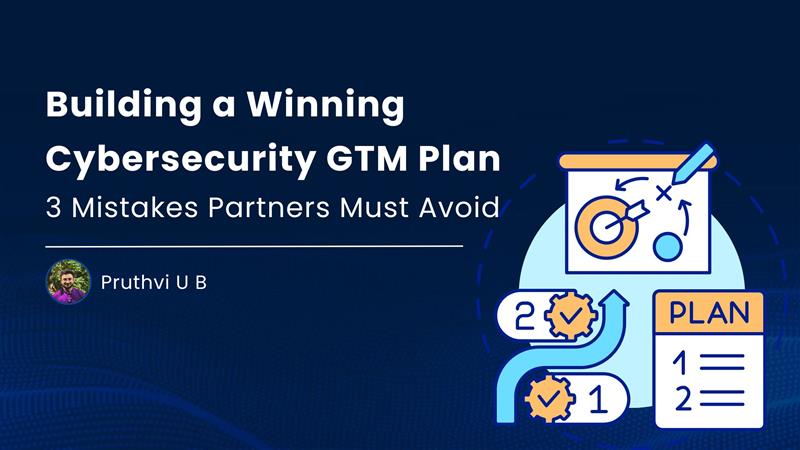Most partners don’t lose deals because the tech is bad. They lose them to avoidable GTM mistakes – building offers around tools instead of prevention outcomes, overlooking the economics of a fragmented stack, and showing weak proof of value. Fix those three, and your pipeline, margins, and renewals start behaving.
Mistake #1 – Building Offers Around Tools Instead of Prevention Outcomes
What Goes Wrong
Too many partners design their GTM playbooks around what tools they have in their stack. Service tiers read like vendor bundles: “Basic = AV + Firewall,” “Advanced = EDR + SIEM,” “Premium = EDR + XDR + Threat Intel.” Customers don’t care about how many logos are in the bundle – they want assurance that their business is safe, their risks are reduced, and their compliance gaps are closed.
Why It Hurts
-> No differentiation: You end up looking like every other provider pushing the same set of tools.
-> Reactive positioning: Customers see features and alerts, not proactive prevention.
-> Low trust: Buyers hesitate when they can’t see clear outcomes that matter to them – faster patch cycles, reduced vulnerabilities, or smoother audits.
The Fix
-> Shift from tools to outcomes: Build services that promise Ransomware Prevention, Cloud Misconfiguration Remediation, or Audit-Ready Compliance.
-> Define metrics: Show impact through reduced attack surface, SLA-driven patch timelines, or compliance readiness scores.
-> Anchor on prevention: A unified prevention-first platform makes this easier- letting you package proactive risk reduction as a service instead of reactive alert handling.
Mistake #2: Overlooking the Economics of a Fragmented Stack
What Goes Wrong
At first, using multiple point tools for different security functions feels manageable. But over time, the costs pile up – overlapping licenses, separate training, complex integrations, and hours lost toggling between dashboards. This tool sprawl makes service delivery expensive, inconsistent, and difficult to scale.
Why It Hurts
-> Rising costs: Licensing and managing multiple vendors cut into margins.
-> Operational drag: Engineers spend more time on manual work instead of delivering value.
-> Scaling bottlenecks: Each new customer means adding more overhead, not more profit.
The Fix
-> Consolidate your core: Simplify delivery by choosing a platform that unifies vulnerability management, patching, risk prioritization, and compliance.
-> Automate the repetitive: Automated patch deployment, prioritized remediation, and instant compliance reporting reduce manual load and cost per customer.
-> Rebuild pricing models: With predictable delivery economics, you can offer clean, outcome-based packages that scale profitably.
Mistake #3: Showing Weak Proof of Value
What Goes Wrong
Many partners deliver reports that look like endless lists of alerts, tickets, and incidents. That doesn’t prove risk reduction – it just shows activity. Customers, auditors, and insurers want real evidence that exposure is shrinking and compliance controls are being met.
Why It Hurts
-> Renewals stall: Clients don’t see the value of staying with you if they can’t see progress.
-> Compliance pressure: Frameworks like NIST, ISO, PCI, and HIPAA demand mapped evidence, not raw data dumps.
-> Lost upsell opportunities: Without clear outcomes, it’s harder to expand the account.
The Fix
-> Deliver “proof packs” with every service: Include risk dashboards, executive one-pagers, and compliance-mapped evidence.
-> Report prevention, not just activity: Highlight SLA adherence (e.g., “critical patches applied within 72 hours”), reduction in vulnerabilities, and measurable drops in attack surface.
-> Automate reporting: Platforms that automatically track and generate compliance-ready evidence make it easy to show value consistently.
Bottom Line
Winning GTM plans aren’t built on flashy tool bundles. They’re built on prevention-first outcomes, unified delivery economics, and irrefutable proof of value.
Partners who get this right –
1. Stand out by selling prevention, not just detection.
2. Protect margins by consolidating and automating.
3. Secure renewals by showing proof of risk reduction every quarter.
One powerful strategy is to anchor your GTM on a unified prevention-first platform that automates patching, risk prioritization, and compliance reporting. It’s the surest way to deliver measurable outcomes, scale profitably, and walk into renewals with proof in hand.
Click here to join our partner network – https://www.secpod.com/partners/

